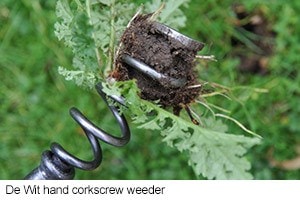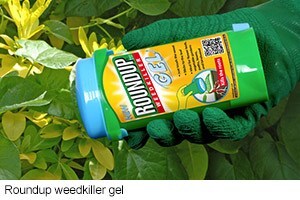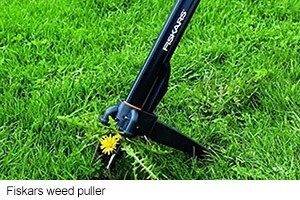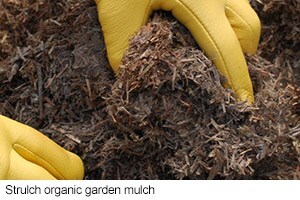Creating a weed-free garden
Tools for the job
Weeding is commonly cited as one of the most time-consuming and onerous tasks in the garden. But it needn’t be. What’s required is a three-pronged attack: catch them early; be persistent; and be careful who you invite into your garden. By tackling weeds now you can enjoy a largely weed-free plot for the rest of the year.
Weeder's armory
- Hoe – ideal for scuffing off annual weeds between plants and crops.
- Weed fork – useful for levering out small perennial weeds, taking care to remove all the roots.
- Border spade – effective for removing shallow-rooting perennial weeds, such as couch grass and brambles.
- Spot weeder – good for dabbing on isolated weeds.
- Bramble killer – ideal for eradicating tough weeds such as brambles, nettles, horsetail and bracken.
- Weed killer
 Weeding effectively When tackling a weedy patch, you need to prevent the problem getting any worse by targeting the more mature weeds, to stop them flowering and self-seeding all over the place. The old adage of “one year’s seed is seven years’ weed” isn’t far from the mark. Don’t fall into the trap of just prioritising monster weeds, though, since troublesome diminutive characters, such as shepherd’s purse, that flower and seed when just a few centimetres tall, will run amok. Even if you have a very weedy garden, that will take months to weed completely, use the same approach. Otherwise, you’ll be weeding-out their offspring for many years to come.
Weeding effectively When tackling a weedy patch, you need to prevent the problem getting any worse by targeting the more mature weeds, to stop them flowering and self-seeding all over the place. The old adage of “one year’s seed is seven years’ weed” isn’t far from the mark. Don’t fall into the trap of just prioritising monster weeds, though, since troublesome diminutive characters, such as shepherd’s purse, that flower and seed when just a few centimetres tall, will run amok. Even if you have a very weedy garden, that will take months to weed completely, use the same approach. Otherwise, you’ll be weeding-out their offspring for many years to come.
It’s worthwhile getting to know your weeds, then you’ll have a better chance to snuffle them out before they can cause long-term trouble. Weeds fall into two main groups: annuals that grow, flower and set seed in the same year then die of natural causes; and perennial weeds that grow and flower year after year. Annuals are the easiest to eradicate - simply hoe them off (or hand weed them) before they flower to prevent future generations. Keep the blade of the hoe sharp and let it glide back and forth, skimming the soil surface and severing the weeds from their roots. Perennial weeds, such as dandelion, bindweed, bramble, couch grass, are more difficult, because they will resprout from underground parts, so need to be removed, with roots intact, or killed outright.
In beds and borders Being an organic gardener, I don’t use chemical weedkillers at all, so have to rely on guile and cunning to get the better of troublesome weeds. Take bindweed, for example – a pretty twiner that’s a regular wolf in sheep’s clothing. If it’s tangled up in your border plants, the best technique is to cut it off at the roots and let the top-growth wilt before pulling it from borders. If you try to remove it fresh, its spiraling stems will grip all the tighter, so that you end up damaging the soft growth and flowers of your prized plants as you rip the weed clear. That’s not the end of the story, of course, because bindweed will resprout from its brittle, bootlace-like roots below ground. The organic gardener has to be persistent and keep chopping back the rosettes of new leaves that reappear, to gradually weaken the weed into submission.
 If you don’t mind using chemicals, on the other hand, you can tackle bindweed with a glyphosate-based weedkiller. Individual weeds can be treated using a spot-weeder to dab the leaves with chemical, or you can carefully spray new weed growth after covering nearby ornamental plants with polythene. Don’t forget to leave the polythene in place until the chemical has dried. In a crowded border, a crafty gardener’s trick is to push in a bamboo cane alongside the weed and allow the spiraling stems to climb. Then slip out the cane and push the weed’s top-growth into a polythene bag (without detaching the weed from its roots) before spraying weedkiller inside the bag. Once the chemical has done its work, the weed and its roots will have been killed leaving adjacent plants completely unaffected.
If you don’t mind using chemicals, on the other hand, you can tackle bindweed with a glyphosate-based weedkiller. Individual weeds can be treated using a spot-weeder to dab the leaves with chemical, or you can carefully spray new weed growth after covering nearby ornamental plants with polythene. Don’t forget to leave the polythene in place until the chemical has dried. In a crowded border, a crafty gardener’s trick is to push in a bamboo cane alongside the weed and allow the spiraling stems to climb. Then slip out the cane and push the weed’s top-growth into a polythene bag (without detaching the weed from its roots) before spraying weedkiller inside the bag. Once the chemical has done its work, the weed and its roots will have been killed leaving adjacent plants completely unaffected.
Under trees and shrubs Under permanent plants, such as trees and shrubs, you can smother weeds using pieces of old carpet or a sheet of thick black polythene, topped with chipped bark to improve its appearance. Otherwise, it is a matter of hand weeding and then covering the weed-free soil with a thick organic mulch or mulch-mat to prevent further flushes of weed seedlings. Some types of trees and shrubs are prone to producing suckers from the roots, these need to be removed carefully to prevent them reappearing. Don’t simply cut them off at ground level since this will just encourage further suckers to be produced. Instead, excavate the soil around the sucker to reveal its point of origin, then cut it cleanly from the root.
 Uncultivated ground If the ground has been left for just a year or two, the main problem will be annual weeds. Walk over the area and remove any young perennial weeds by hand, including the roots, as well as any flowering annuals. Then clear the majority of the annual weeds systematically using a garden hoe. Alternatively, you could treat the area with weedkiller using a knapsack sprayer. On ground that has been left abandoned for many years, perennial weeds are likely to dominate and be very well established; these include coarse grasses and deep-rooted perennial weeds, such as field bindweed and horsetail, as well as impenetrable thickets of woody-stemmed weeds like brambles. All these weeds are more difficult to eradicate. Hand weeding will be very hard work and time consuming, or you could try cutting back all the top growth and smothering the roots with old carpet – but this can take years to be effective. If you don’t mind using chemicals, a far quicker solution is to apply a bramble weedkiller, that’s formulated to tackle woody weeds.
Uncultivated ground If the ground has been left for just a year or two, the main problem will be annual weeds. Walk over the area and remove any young perennial weeds by hand, including the roots, as well as any flowering annuals. Then clear the majority of the annual weeds systematically using a garden hoe. Alternatively, you could treat the area with weedkiller using a knapsack sprayer. On ground that has been left abandoned for many years, perennial weeds are likely to dominate and be very well established; these include coarse grasses and deep-rooted perennial weeds, such as field bindweed and horsetail, as well as impenetrable thickets of woody-stemmed weeds like brambles. All these weeds are more difficult to eradicate. Hand weeding will be very hard work and time consuming, or you could try cutting back all the top growth and smothering the roots with old carpet – but this can take years to be effective. If you don’t mind using chemicals, a far quicker solution is to apply a bramble weedkiller, that’s formulated to tackle woody weeds.
Paths and steps Clear cracks of weeds using an old kitchen knife or special weeding tool that hooks them out roots and all. Individual weeds in gravel areas are often easy to pull by hand, but if the weed problem is widespread, you might prefer to apply a path weedkiller.
Applying weedkillers safely
- Choose a calm, dry day.
- Read and follow the instructions on the label.
- Keep weedkillers away from ponds and water courses.
- Wash out equipment thoroughly after applying weedkillers.
Preventing more weeds Once you have cleared weeds from your garden, use the following methods to help keep you garden weed-free:
- Loose mulch – a generous 5cm-deep organic mulch will suppress new weeds on beds and borders. Gravel or stone chippings will do the same on paths and rockeries.
- Mulch-mat – black polythene can be as effective as a weed-suppressing mulch between crops on the veg patch and within the fruit garden. Mulch-mats are useful for some crops and individual trees.
- Groundcover – vigorous, low-growing ornamental plants can be used to out-compete weeds for space. But you will need to plant them in weed-free soil, and hand weed the groundcover plants until they have formed a dense carpet.
 Uninvited guests Weeds can find their way into your garden in a variety of ways. You may not be able to prevent them blowing in or being deposited by birds and other animals, but you can avoid introducing them yourself. For this reason it is a good idea to check all new plants carefully for stowaways and consign any weeds found to the dustbin. Another source of new weeds is imported topsoil and organic manure, so make sure you buy from a reputable supplier. Even your own garden compost could make your weed problems worse when you spread it around the garden. So make sure you don’t add perennial weed roots or seeding weeds to your compost heap.
Uninvited guests Weeds can find their way into your garden in a variety of ways. You may not be able to prevent them blowing in or being deposited by birds and other animals, but you can avoid introducing them yourself. For this reason it is a good idea to check all new plants carefully for stowaways and consign any weeds found to the dustbin. Another source of new weeds is imported topsoil and organic manure, so make sure you buy from a reputable supplier. Even your own garden compost could make your weed problems worse when you spread it around the garden. So make sure you don’t add perennial weed roots or seeding weeds to your compost heap.
